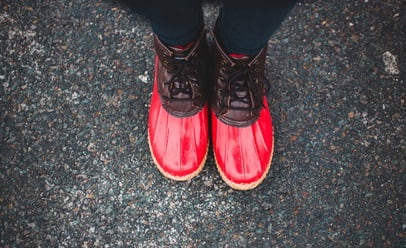
Walking shoes vs walking boots – which to choose?
Are you looking to buy a new pair of walking trainers, but do not know the difference between walking boots vs shoes? If so, this article will be useful for you!
In this post, we will provide you with basic knowledge about the two types of trainers and assist you in choosing your suitable one. Let’s dive in to discover now!
Walking Boots Vs Shoes — A Full Comparison
Walking boots are typically more expensive and provide additional support for your feet. Meanwhile, shoes are less expensive and offer less foot support than walking boots do. The key thing to consider when deciding which footwear to purchase is where you will be using it most often. Continue reading to have a close look at them!
Terrain
Choosing which shoes to wear for a long walk depends on the kind of terrain you will be walking over. For example, to avoid any injuries to the foot, wearing boots is recommended. More specifically, they protect your feet from sharp rocks and sticks that may be encountered during a walk in nature. If you normally walk on a relatively clean and flat surface, it is better to wear lightweight sneakers than boots.

Do not forget to take into account types of terrain when choosing hiking shoes or boots
When going on a hike, it is important to choose the right footwear. In detail, the best option for longer hikes is walking boots. They will protect your feet and ankles when you encounter rockier terrain and provide more support than other types of shoes.
Shorter walks around an hour-long or less are perfect for comfortable walking shoes because they have more flexibility and allow better movement. Hiking boots made from thicker material do not work during these short distances as well, compared to the flexible ones that offer a higher level of comfort.
Weight
When comparing the weight between walking shoes vs walking boots, the later ones are often heavier than walking shoes. If you’re going for a short stroll, you don’t want to be weighed down by hefty boots!
Meanwhile, climbing and hiking on a steep slope or mountain are easier in walking shoes, thanks to their thin soles. These light, low-profile sneakers are ideal for agility as they do not weigh you down as much when going uphill. On the other hand, they still provide enough protection against rocks and other obstacles outside the trail.
Waterproofing
With the weather in the UK, you need to have shoes that can stand up against anything! Walking shoes are not as durable and offer less protection than walking boots. However, they are breathable, which is good when it’s hot outside. Waterproofing your boots should be used for extra safety measures before going on any hikes or long walks in cold weather.

Waterproof boots are best for wet weather.
A walking shoe is best for dry weather because they are breathable, but a waterproof lining isn’t always included. These shoes can also be more lightweight and good for the summer than other types of footwear. If you want to stay protected in wetter conditions, it is better to get boots that have thicker material or GORE-TEX inside them. These materials make your feet less breathable as well as keep water out.
Support & Protection
When hiking off the beaten path, you will need a good pair of shoes with ankle support to protect your feet and ankles from scratches. Specifically, this is especially important in avoiding sprains caused by tripping over rocks or roots on uneven terrain. Thick ankle coverings on boots can help keep your feet and ankles safe. Boots may also help if the ground is not even.

Choose suitable trainers to protect your feet!
To find the best shoes for walking, you must consider how much activity they will be used for. If your walks are leisurely and light on trails or roads with no hills, then tennis sneakers would suffice just fine. When you need to do more strenuous work, such as hiking long distances over rough terrain, thicker boots might better support your feet throughout this wear.
Weather And Seasons
Lighter shoes may be best for your feet when it’s hot outside. When walking around, you might find yourself sweating more than usual if wearing heavy or thick-soled shoes. In particular, your feet will stay cool and comfortable in less material.
When it rains, mud and wet ground are likely to make your walk more difficult. In such a case, you possibly want to wear boots to decrease the wetness of your feet. In the cold winter, walking boots are great for securing your feet from getting wet and prevent you from slipping on ice.
Walking Boots Vs Shoes — Which One Should You Buy?

If you can afford both, do it!
When it comes to picking between walking shoes vs walking boots, you must first consider your purpose of wearing them. If your hiking excursions are light and short with not too much distance involved, then a pair of lightweight trainers should do the trick (though they will not stand up well in deeper water).
Nevertheless, suppose you’re going on longer hikes or have more rugged trails ahead of you over challenging terrain during colder months. In that case, we recommend top-of-the-line waterproofing for maximum protection – which is why many hikers choose winter boots!
If you’re thinking about buying both, then make sure you get a pair of trainers which are right for the type and style of the walker. Also, be careful when shopping to ensure they fit properly, as this can influence how well your feet respond on those long walks in all conditions.
Conclusion
The next time you head out for a walk, choose the right shoes! Think carefully about which one to wear between walking boots vs shoes. If your goal is to stay healthy and prevent injury, invest in some walking boots or running shoes with good traction! Lastly, remember to choose the one that fits your wearing purpose for the best protection and performance!





